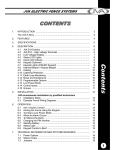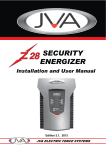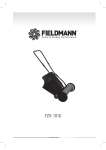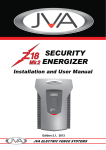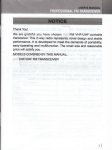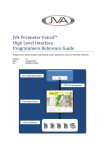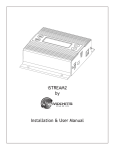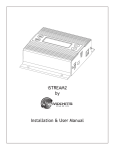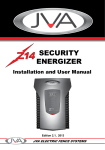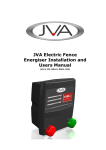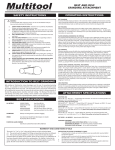Download Z28 Security Energizer
Transcript
JVA ELECTRIC FENCE SYSTEMS CONTENTS INTRODUCTION ...................................................................................... The JVA Z Story ........................................................................................ 3 3 2. FEATURES ............................................................................................... 4 3. SPECIFICATIONS .................................................................................... 5 4. DESCRIPTION ......................................................................................... 4.1 JVA Z28 Exterior .............................................................................. 4.2 JVA Z28 – High Voltage Terminals .................................................. 4.3 LCD Voltage Display ........................................................................ 4.4 Status LED Lights ............................................................................ 4.5 Inputs and Outputs .......................................................................... 4.6 Keypad (Optional) ............................................................................ 4.7 Keypad Lights (236LED Keypad) .................................................... 4.8 Internal Beeper / Keypad Beeper .................................................... 4.9 Cabling ............................................................................................ 4.10 Lightning Protection ......................................................................... 4.11 Earth Loop Monitoring ..................................................................... 4.12 Noise and Interference .................................................................... 4.13 Programmable Options .................................................................... 4.14 Low Power Mode ............................................................................. 4.14 Control Inputs .................................................................................. 4.16 Groups ............................................................................................. 6 6 6 7 8 8 9 9 10 10 10 10 10 10 11 11 11 5. INSTALLATION ......................................................................................... JVA recommends installation by qualified technicians 5.1 Installation Steps ............................................................................. 5.2 Example Fence Wiring Diagrams .................................................... 12 6. OPERATION ............................................................................................. 6.1 Arm / Disarm Control ....................................................................... 6.2 Arming the Fence Using the Keypad ............................................... 6.3 Turning to Low Power Mode ............................................................ 6.4 When an Alarm Occurs .................................................................... 6.5 To Silence the Alarm ........................................................................ 6.6 Changing the PIN number ............................................................... 6.7 Standby Battery ............................................................................... 6.8 Status Light ...................................................................................... 6.9 Keypad Control in Brief .................................................................... 14 14 14 14 14 15 15 15 15 16 7. TECHNICAL INFORMATION NEW PICTURE REQUIRED ..................... 7.1 Power Options ................................................................................. 7.2 Status Codes ................................................................................... 7.3 Jumpers ........................................................................................... 17 18 18 18 Contents 1. 12 13 1 Contents JVA ELECTRIC FENCE SYSTEMS 8. INSTALLATION PROGRAMMING OPTIONS .......................................... 8.1 Programming Mode ......................................................................... 8.2 To Exit Programming Mode ............................................................. 8.3 Changing the Installer PIN ............................................................... 8.4 Changing an Option ......................................................................... 8.5 Programming Options in Brief ......................................................... 8.6 Programming Options in Detail ........................................................ 8.6.1 Power Level (01x#) .............................................................. 8.6.2 Low Power Level (02x#) ...................................................... 8.6.3 Fence Alarm Voltage (03x#) ................................................ 8.6.4 Fence Alarm Voltage Channel 2 (04x#) ............................... 8.6.5 Low Power Alarm Level (05x#) ............................................ 8.6.6 Missed Pulse Count (06x#) ................................................. 8.6.7 Battery Alarm Voltage (07x#) ............................................... 8.6.8 Siren On Time (08x#) .......................................................... 8.6.9 Siren Off Time (09x#) .......................................................... 8.6.10 Siren Cycles (10x#) ............................................................. 8.6.11 Input Type (11x#) ................................................................. 8.6.12 Input 3 Function: Gate2/Low Power Mode (12x#) ............... 8.6.13 Gate Entry/Exit Delay (13x#) ............................................... 8.6.14 Chime Mode (14x#) ............................................................. 8.6.15 Fence Mode (15x#) ............................................................. 8.6.16 Relay Functions ................................................................... 8.6.17 Relay Function Details ......................................................... 19 19 19 19 19 20 21 21 21 21 22 22 22 22 23 23 23 24 24 24 24 24 25 25 9. ALPHA PLUS LCD KEYPAD FEATURES ................................................ 26 9.1 9.2 9.3 9.2 Using the Alpha Plus LCD Keypad .................................................. Changing the Keypad Messages ..................................................... To Exit Keypad Programming .......................................................... Other Keypad Functions .................................................................. 26 26 27 27 10. SECTOR SETUP TESTS AND ADJUSTMENT ........................................ 10.1 Basic Fence Tests ........................................................................... 10.2 Fault Condition Tests ....................................................................... 28 28 29 11. S.A. STANDARD REQUIREMENTS FOR ELECTRIC SECURITY FENCES ................................................................................ 30 11.1 Definitions ........................................................................................ 11.2 Installation, Operation and Maintenance ......................................... 11.3 Warning signs .................................................................................. 11.4 Gates ............................................................................................... 11.5 Earthing ........................................................................................... 11.6 Protection ........................................................................................ WARRANTY ............................................................................................. 30 30 31 31 31 32 35 12. 2 JVA ELECTRIC FENCE SYSTEMS 1. INTRODUCTION Welcome to the world of JVA monitored electric security fences. The proliferation of non-lethal, monitored, electric security fences in our towns and cities is indicative of the confidence the public has in this form of perimeter security. The reason for this popularity is simple – monitored electric security fences are effective, economical, simple to install, and they offer more D’s of security than any other perimeter system: Every second, the JVA Z energiser discharges a very short-duration, safe, high-voltage pulse down the fence live wire. The JVA Z energiser then monitors the voltage at the end of this live wire, thereby checking that the voltage is being maintained along the entire fence line. In the event of a voltage drop caused by either shorting, cutting or poor maintenance, the monitor will trigger an alarm, thus alerting you. Introduction DEMARCATION – The JVA fence around your property shows you mean business. DEFLECTION – Would-be intruders will be deflected to softer targets. DETERRENCE – The safe, powerful JVA shock is a strong deterrent to intruders. DELAY – The physical barrier will delay an intruder, something they do not like. DETECTION – The JVA’s voltage monitor warns you of any tampering with the fence. DENY – A well-erected electric security fence will deny entry. DEPENDABLE – 60 seconds a minute, 60 minutes an hour, 24 hours a day, 365 days a year, your JVA electric security fence is monitored by an alert, sober, electronic watchman. Manufactured to meet the most stringent international safety standards, the JVA Z energiser is in a class of its own when it comes to features and benefits at an affordable price. An electric fence system which meets current safety regulations 3 JVA ELECTRIC FENCE SYSTEMS 2. FEATURES 2.1 Power ● 8 joules peak output energy (4 + 4 Joules = 8 Joules total) ● Mains powered via external transformer (16–18Vac) ● Battery charger with space for internal 7A/H 12V rechargeable back up battery 2.2 Control / Monitoring: ● 3 Control inputs which can be configured to take N.O. or N.C. control contacts. ● 3 12V driven outputs (also referred to as relays), high side switched (common Features negative) ● All relays may be assigned to any alarm function ● LCD voltage display ● LED status lights ● Internal beeper ● AC fail, Low Battery and Bad Battery detection ● Keypad programmable options ● Low power mode – ensures detection together with public safety during the day ● Adjustable energiser power output level 2.3 Safety ● Designed to pass IEC60335.2.76 and EMC standards (reports available on request) ● Enclosed fence terminals ● Wall mountable, robust enclosure with detachable PCB chassis for ease of installation and repair 2.4 Reliability ● Microprocessor controlled. ● Pluggable screw terminals ● State of the art, robust, case design IP4x ABS ● Inbuilt lightning protection from both mains and fence sides, external fence lightning protection is still advised in high lightning prone areas ● All inputs and outputs protected against stray fence voltage 4 JVA ELECTRIC FENCE SYSTEMS 3. SPECIFICATIONS Specification Energiser Output Voltage 8.5kV peak no load Peak Output Energy 2 × 4 Joules at 500 Ohms Pulse Rate Crystal locked at 0.8 Hz 12v DC Power Consumption Energiser On – 550mA Average, 700mA peak Energiser Off – 28mA 40mA Not including keypad or auxiliary power AC Power Input 16Vac 2A Battery Charger Output Float voltage 13.8V, 350mA, short circuit protection Outputs 12V 2.5A maximum combined load Enclosure IP4x ABS plastic Size 300mm high, 190mm wide, 115mm deep Weight – packed, no battery 2.5kg Specifications Specification Name WARNING ● There are no user-serviceable parts in this unit. ● The installer is reminded that high voltages are retained for a while after switching off, and to wait for at least 10 minutes before opening the case. ● Before working on the high voltage wiring of an electric fence, it is recommended that the energiser be disarmed and an intentional short circuit is placed from the fence live wires to earth. This is a sensible precaution against the energiser being turned on by others or malfunctioning while working on the fence. 5 JVA ELECTRIC FENCE SYSTEMS 4. DESCRIPTION The Z18 is a single channel, standard (non Bi-Polar) 8 Joule (Output) security energiser. The Z28 is a dual channel standard (non Bi-Polar) 8 Joule (4 per channel) security energiser. Both the Z18 and Z28 are made on the same PCB, for the Z18, single channel version the 2 outputs are bridged. This manual relates to: Description ● PCB versions: 7.51 and higher ● Firmware versions: 7.50 or higher (the firmware version is shown on the LCD on reset) 4.1 JVA Z28 Exterior Figure 1: Z28 4.2 JVA Z28 – High Voltage Terminals ZONE 2 RETURN EARTH RETURN ZONE 1 RETURN ZONE 2 OUT EARTH ZONE 1 OUT Figure 2: Output Terminals in Conventional Mode 6 JVA ELECTRIC FENCE SYSTEMS 4.3 LCD Voltage Display The display on the JVA Z28 shows the voltage at the fence and return terminals. Z28: Left side = Return zone 1, Right side = Return zone 2. The LCD also shows the programming option and current setting when in programming mode. This allows the programming options settings to be checked easily. – RETURN HV – ZONE 2 Description ZONE 1 Figure 3: LCD Display and Status LEDs 7 JVA ELECTRIC FENCE SYSTEMS 4.4 Status Lights Left side Z28 Armed On when the unit is armed (pulsing), will flash when in low voltage mode. Fence On when there is a fence alarm (either zone). Gate On when there is a gate alarm. Description Right side Z28 Power On whenever the unit has power. Armed On when the unit is armed (pulsing), will flash when in low voltage mode. Fence On when there is a fence alarm (either zone). Gate On when there is a gate alarm. Status Flashes a code for energiser conditions. See the table in section 7.2 – Status Codes. 4.5 Inputs and Outputs 16VAC Output Feed terminals Output Return terminals Keypad Control Inputs Control Outputs 16VAC Only! Figure 4: Connection Terminals 8 JVA ELECTRIC FENCE SYSTEMS 4.6 Keypad (0ptional) A keypad can be used to remotely monitor and control the Z28. It is also used to set the programmable options. See section 8.5. LCD screen 4.7 Keypad Lights Power On with AC power, flashes on low battery. Service On with any Energiser fault (like low battery). Arm On when the Energiser is armed (pulsing), flashes when in low power mode. 1 On when there is a fence fault (positive wires for Bi-Polar). 2 On when there is a fence fault negative wires (Bi-Polar mode only). 3 On when the gate input is open. 4, 5, 6 Not used Description Figure 5: LCD Keypad NOTE: There is no panic function. For information on how to control the Z28 via the keypad see section 6. 9 JVA ELECTRIC FENCE SYSTEMS 4.8 Internal Beeper/Keypad Beeper Depending on the chime setting, the internal beeper and keypad beeper will sound when there is a fence alarm, a gate alarm or a general alarm or a door chime. On flat battery the keypad will always beep 4 times before the energiser automatically enters low voltage mode to preserve the battery. On AC Fail it will not beep. 4.9 Cabling Description High voltage cabling (fence lead out and returns) should be run using suitably rated cable. Double insulated electric fence “underground” cable is suitable. High Voltage Cables must never be run within the same conduit as Low Voltage Cables. A minimum distance of 30mm should be kept between High Voltage and Low Voltage cables. 4.10 Lightning Protection Although the Z28 contains internal lightning protection elements, external lightning protection elements such as additional external lightning kits available from your local dealer, are recommended as they would help to reduce lightning damage even further. 4.11 Earth Loop Monitoring The Z28 has two fence earth terminals which when wired into an insulated series looped fence system enable the energiser to monitor the earth circuit. If this is not required the installer can loop the two earth terminals at the energiser and then connect the earth spikes to one of the parallel earth terminals. 4.12 Noise and Interference The Z28 contains a microprocessor. Extreme electrical noise can upset microprocessors. The most likely cause of such noise is the high voltage output from the unit itself. In the event of erratic behaviour, check that the high voltage wiring is firmly connected to the terminals and that no sparking is seen. The Z28 is designed to self-recover from interference, powering off (both AC and battery) should not be necessary. 4.13 Programmable Options The Z28 has many programmable options. These are also known as setup parameters. To alter these options a keypad must be used. The options are explained in Programming Options in Brief on page 20. Each parameter has a factory set default. 10 JVA ELECTRIC FENCE SYSTEMS 4.14 Low Power Mode Z28 energisers can be switched into low power mode. Low Power mode may be used in situations where the fence is not required to be a deterrent but is still required to actively detect intrusion. In Low Power mode the fence live wires operate at a much lower voltage, typically 500V peak. See Programming Options in Brief on page 20 for details on using the keypad to set low voltage mode. 4.15 Control Inputs The Z28 has 3 control inputs. These default to: The gate inputs may be wired to a gate switch to trigger an alarm when a gate is opened. If the unit is disarmed, the gate input may be set to chime mode. See Programming Options in Brief on page 20. NOTE: If not used, the Gate 1 and Gate 2 inputs must be bridged to the Com terminal. 4.16 Groups The Z28 may not be linked in group mode. Description Input 1 – Arm/Disarm Input 2 – Gate 1 Input 3 – Gate 2 11 JVA ELECTRIC FENCE SYSTEMS 5. INSTALLATION JVA recommends installation by qualified technicians. Installation 5.1 Installation Steps 1. Read the entire manual first! 2. Design and build the fence. (Beyond the scope of this manual.) 3. Decide where the JVA Z28 is to be mounted. If on an external wall it should be housed within an equipment box and definitely not in direct sunlight or where it could get wet. 4. Mount the unit by hanging the housing on the two nail-in anchors provided. If necessary, two extra mounting holes can be used at the bottom of the housing. 5. If using a keypad, remove the rear housing of the keypad and fix it to the wall. 6. Wire the low voltage cables to the PCB terminals (right side)*. (See page 8) 7. Wire the high voltage cable to the PCB terminals*. (See page 8) 8. Fit the battery leads to the battery. The Status LED should blink twice to show mains fail. 9. The unit is designed not to start when first powered up irrespective of the state of the inputs. 10. Replace the front cover. 11. Turn AC power on. 12. Arm and disarm the energiser via the keyswitch or keypad, if fitted. The Status LED should stop blinking. 13. Arm the unit. The LCD display will now show the fence voltage. 14. Check to ensure that a short anywhere on the fence triggers the alarm. 15. On handing the system over to the owner/user, explain how to change the user PIN. Leave a User Manual with the user. *NB 12 Keep high voltage and low voltage cables at least 100mm apart. Do not run high and low voltage cables in the same conduit. JVA ELECTRIC FENCE SYSTEMS 5.2 Example Fence Wiring Diagrams Feed Return Installation Return 2 Earth Return 1 Feed 2 Earth Feed 1 Fence 1 Fence 2 Earth spikes JVA Z28 Energiser Fence Wiring, Including Earth Monitoring 13 JVA ELECTRIC FENCE SYSTEMS 6. OPERATION 6.1 Arm/Disarm Control The unit can be controlled by the control input 1 or via a keypad. The keypad also allows instant audiovisual indication of the state of the energiser and therefore the fence it is powering. If there are two ways to control the energiser both connected at once, i.e. keypad and control inputs, then the last change will determine the result. So if the unit is armed via the keypad and then disarmed at the control input it will disarm. 6.2 Arming the Fence Using the Keypad Operation ● Enter your PIN number (four digits long) and push the # key. ● Make sure the red ARM light comes on. ● The keypad will beep twice to confirm that the system is armed. ● The fence will power up and if all is well (no faults) the system will be ready to deter and detect. ● If there is a fault on the fence and it cannot achieve full voltage, zone 1 or zone 2 LCDs will flash. ● To disarm the system, enter your PIN and press #. This will also clear any fault lights and zone lights which may have been on. 6.3 Turning to Low Power mode To switch to Low Power mode, enter your PIN and press *41#. In Low Power mode the fence will still be powered and any breach will be detected, but the voltage will be much lower than normal operation. The ARM light will flash in Low Power mode. Enter your PIN and press *42# to switch back to Full Power mode. Alternatively, the unit can be switched to Low Power mode using the gate switch input, if it has been programmed accordingly. 6.4 When an Alarm Occurs If the system is armed and the fence is tampered with, the corresponding Zone Light will flash on the energiser and then remain on. Relays assigned to alarms will turn on. If the energiser is connected to a building alarm system for monitoring, an alarm signal may be sent to the alarm company monitoring the alarm system. 14 JVA ELECTRIC FENCE SYSTEMS If a keypad is connected to the system, pressing the # key will identify the zone condition. An alarm will also sound if input 2 is assigned to the “gate input” function and the gate input is opened and the entry/exit delay time has elapsed. 6.5 To Silence the Alarm ● Enter your PIN and press #. This will silence the alarm but not disarm the system; the Armed Light will still be on. The system will be ready for the next alarm. zone light. ● Alternatively, disarming using the key switch will reset the alarm. 6.6 Changing the PIN Number ● ● ● ● ● Enter the old 4-digit PIN and press *0#. This enters User Programming mode. Enter your new PIN (must be 4 digits) and then #. Press *# to exit User Programming mode. Make sure your new PIN works by using it to arm the energiser. The default PIN is 1 2 3 4. Operation ● The zone lights on the keypad will flash to show where the breach occurred. ● The siren and strobe are ready to respond again if triggered. ● To disarm the system, enter your PIN and press # again. This will also clear the 6.7 Standby Battery Should there be a loss of mains power, the Power Light on the keypad will go off. Output power will be reduced to conserve battery power. If the loss of power is prolonged, the battery may discharge power and become ineffective. The Power Light will start to flash indicating a battery low power problem. If the standby battery requires replacement, the Power Light will flash and the Status Light will be on. 6.8 Status Light If the energiser develops an internal fault, the Status Light will flash a code. See section 7.2 (page 18). 15 JVA ELECTRIC FENCE SYSTEMS 6.9 Keypad Control in Brief In the following table, XXXX is the 4-digit PIN. The default PIN is 1 2 3 4. Operation ACTION 16 PRESS KEYS Turn on / ARM XXXX# Turn off / DISARM XXXX# Silence an alarm XXXX# Arm All Zones (Multizone systems) XXXX# Arm Zone 1 or Master XXXX*11# Arm Zone 2 (2 Zone models only) or slave 2 etc. XXXX*12# Disarm All Zones XXXX*20# Disarm Zone 1 or Master XXXX*21# Disarm Zone 2 XXXX*22# Switch to Low Power mode (all zones) XXXX*41# Switch to High Power mode (all zones) XXXX*42# JVA ELECTRIC FENCE SYSTEMS 7. TECHNICAL INFORMATION Figure 6: Low Voltage Terminals Label Type Description Keypad 3 Way Supplies power and data line for an external keypad. The +12 source on these terminals is protected with a 1A selfresetting fuse. Inputs 4 Way Energiser control inputs (dry contact). Defaults to normally open. Can be used for a remote switch or a radio receiver. The receiver may be powered from the keypad +12V terminal. See section 4. Outputs 4 Way Siren and Strobe or other outputs. See section 4 and 8 (Programming Options). AC IN 3 Way 16Vac power input. Fused via F3 1A self-resetting fuse. Batt Leads 12V dc or battery connection via F1 (3 Amp self-resetting fuse. Technical information 16 VAC ONLY Low Voltage Terminals NOTE: To reset the fuse, remove power for a few seconds and then reapply power. 17 JVA ELECTRIC FENCE SYSTEMS 7.1 Power Options Technical information The unit has 2 sources of power, 16VAC and 12VDC (Battery). NOTE: Use only rechargeable batteries. Always ensure adequate ventilation is available for the housing if it contains a battery. Lead acid batteries may emit explosive gases while charging! Always make sure that a battery is connected to the energiser before applying AC. 7.2 Status Codes Status LED Number of Flashes Interpretation 1 Not used 2 16 VAC Mains fail Restore mains power. Can be bypassed by fitting J3 3 Low battery, bad battery Charge or replace battery 4 PCB service fault Return to repair/service centre Status Codes If an error occurs, the relay assigned to general alarm will go into alarm state. Minor errors will self clear if the error condition is removed. If the mains power fails, it will not disarm the energiser, nor will low battery. However, without mains power, the battery will eventually be depleted and the energiser will attempt to maintain operation by entering low power mode after 4 warning beeps. If the battery charge continues to fall, the energiser will eventually stop. Once mains power has been restored and the battery has recovered, the energiser will re-arm itself automatically after 4 warning beeps. A PCB fault will disarm the energiser. If an error disarms the energiser, the general and fence alarms will activate. If an error has momentarily caused the energiser to stop pulsing, this can be corrected by disarming and rearming the unit. Should the error recur, return the unit for service. 7.3 Jumpers The unit has two special purpose jumpers (links). These are listed in the table below. Jumper Function Purpose J3 DC only jumper Fit J3 to inhibit mains fail errors, if the intention is to operate the unit on DC only (as in Solar Power systems) J4 Factory default jumper Off to return programmable options to factory defaults upon power up If the energiser needs to be defaulted to factory settings, remove all power – AC and battery and remove the J4 jumper. Reapply the battery power first, then 16 VAC power. Reapply the J4 jumper and the unit will be reset to default settings. Jumpers 18 Corrective Action JVA ELECTRIC FENCE SYSTEMS The unit has a non-volatile memory in which programming options (setup parameters) are held. These are factory pre-set but can be field programmed using a keypad. 8.1 Programming Mode To enter Programming mode, enter the 6-digit installer PIN followed by *0# keys. The keypad will beep twice to indicate that the command was accepted. If the PIN was incorrect, the keypad will beep 3 times. The LCD will now show the first programming option and its current setting. Pressing the # key will cycle through all the options on the LCD. NOTE: Not all numbers are used. The default installer PIN is 0 1 2 3 4 5. 8.2 To Exit Programming Mode After programming, press *# to exit. If left unattended, the unit will time out and auto exit Programming mode after approximately 5 minutes. 8.3 Changing the Installer PIN The installer PIN may only be changed while in Programming mode. To enter a new installer pin, press 00 followed by the new 6-digit PIN, then the # key. If you cannot remember your installer or user PIN, return the unit’s memory to default. To do this, remove power (AC off and disconnect the battery), open the energiser, remove jumper J4 and reconnect the battery for about 10 seconds. Do not forget to re-fit J4. This will return all options to the factory set defaults. 8.4 Changing an Option Most of the options have possible values in the range of 0 to 9. To change any options, the unit must be in Programming mode. Check the option number (see table below) and then the table of values for that option. Then press the option number followed by the required value. When the programming is completed, exit from Programming mode. (See 8.2 above.) For example, to change the power level to maximum press 019#, the keypad will beep twice to indicate that the command was successful. The LCD will immediately show the updated value. Installation Programming Options 8. INSTALLATION PROGRAMMING OPTIONS 19 Installation Programming Options JVA ELECTRIC FENCE SYSTEMS 8.5 Programming Options in Brief See page 21 for more detail. Option Function Description 01 Power Level Sets the output power levels 02 Low Power level Sets the output power levels used in Low Power mode 03 Fence Alarm Voltage Zone 1 Sets the voltage threshold below which the fence alarm will occur (Zone 1) 04 Fence Alarm Voltage Zone 2 Sets the voltage threshold below which the fence alarm will occur (Zone 2) 05 Low Power Alarm Level Sets the voltage threshold below which the fence alarm will occur in Low Power mode 06 Missed Pulse Count Sets the number of pulses which may be missed before the alarm is activated 07 Battery Alarm Voltage Sets the battery voltage threshold below which the general alarm will activate 08 Siren On Time Sets the time that the siren (and keypad beeper) will stay on after an alarm 09 Siren Off Time The amount of time the siren will be off for after the On time has expired 10 Siren Cycles The number of times the siren will sound for the On time function above. After this many cycles the siren will automatically mute 11 Input Inversion Closed to arm or Open to arm 12 Gate Input Function Gate Switch mode or Low Power Switch mode 13 Gate Exit Delay Time from gate switch opening to alarm 14 Chime Mode Allows the keypad and internal beeper function to be altered 15 – 20 Not used 21 Relay 1 Used to assign an alarm function to output L1 22 Relay 2 Used to assign an alarm function to output L2 23 Relay 3 Used to assign an alarm function to Siren or output 3 24 Relay 4 Used to assign an alarm function to output 4, on the optional daughterboard 25 Relay 5 Used to assign an alarm function to output 5, on the optional daughterboard. 26 Group ID Allows the energiser to be set as a Master or slave in a synchronised group. Not available in all markets. Programming Options 20 JVA ELECTRIC FENCE SYSTEMS Note: The bold panel in each table indicates the default value. 8.6.1 Power Level (01x#) The power level option allows the shocking power of the fence to be adjusted. For example: To change the power level to maximum, enter the following: Value (x) Voltage 0 2.0kV 1 2.6kV 0 1 9 # or 0 1 0 9 #. 2 3.3kV The keypad will beep twice to indicate that the new setting has been accepted. 3 3.9kV 4 4.5kV 5 5.1kV 6 5.8kV This setting affects the average power drain and therefore backup battery time. 7 6.4kV 8 7.0kV Kilovolt settings refer to a 1000 Ohm load, actual fence voltages will depend on the type and length of fence. 9 7.7kV The normal fence voltage depends on the amount of fence wire, the losses and the power level. Value (x) % of High Power Power Level (01x#) 8.6.2 Low Power Level (02x#) Same as above, but for Low Power mode. 0 0.5% 1 1.0% 2 1.5% 3 2.0% 4 2.5% 5 3.0% 0 1.5kV 6 3.5% 1 2.0kV 7 4.0% 2 2.5kV 8 4.5% 3 3.0kV 9 5.0% 4 3.5kV 5 4.0kV 6 4.5kV 8.6.3 Fence Alarm Voltage Zone 1 (03x#) 7 5.0kV This option sets the voltage threshold below which the fence alarm will occur. The default Fence Alarm Voltage is 4 kV. 8 5.5kV 9 6.0kV Low Power Level (02x#) Value (x) Voltage Installation Programming Options 8.6 Programming Options in Detail Fence Alarm Voltage Zone 1 (03x#) 21 Installation Programming Options JVA ELECTRIC FENCE SYSTEMS 8.6.4 Fence Alarm Voltage Zone 2 (04x#) This option sets the voltage threshold below which the fence alarm will occur. The default Fence Alarm Voltage is 4 kV. 8.6.5 Low Power Alarm Level (05x#) This option sets the voltage threshold below which the fence alarm will occur. The default Fence Alarm Voltage is 500 Volts. Value (x) Voltage Voltage 0 1.5kV 1 2.0kV 2 2.5kV 3 3.0kV 4 3.5kV 5 4.0kV 6 4.5kV 7 5.0kV 8 5.5kV 9 6.0kV 0 300 Volts 1 500 Volts 2 700 Volts Value (x) Missed Pulses 3 900 Volts 0 1 4 1100 Volts 1 1 2 2 3 3 4 4 5 5 6 6 7 7 8 8 9 9 Low Power Alarm Level (05x#) 8.6.6 Missed Pulse Count (06x#) This option enables the pulse count to be varied from the default (3). This is the number of bad or missing pulses that are counted before the alarm occurs. NOTE: The lower this option is set, the more likely you are to get false alarms. Keypad Number 0 1 2 3 4 5 6 7 8 9 Alarm 9.0 V 9.5 V 10.0 V 10.5 V 11.0 V 11.5 V 12.0 V 12.5 V 13.0 V 13.5 V Reduce Power 8.0 V 8.5 V 9.0 V 9.5 V 10.0 V 10.5 V 11.0 V 11.5 V 12.0 V 12.5 V Battery Alarm Voltage (07x#) 22 Value (x) Fence Alarm Voltage Zone 2 (04x#) Missed Pulse Count (06x#) 8.6.7 Battery Alarm Voltage (07x#) This option sets the battery voltage threshold below which the alarm will activate. The default Battery Alarm Voltage is 11.0 Volts and the unit will drop to low power at 10.0 Volts (after beeping 4 times). If the unit enters Low Power mode due to a flat battery, the unit will automatically return to high voltage, without warning, when the mains voltage comes back on and the battery voltage rises. JVA ELECTRIC FENCE SYSTEMS Value Time This option sets the duration of time that the siren will remain on after a fence alarm occurs. After this time the siren will turn off for the Off time indicated in Table 8.6.9. The siren will sound again if the alarm is still present after this Off time has passed. The default is 3 minutes. 0 10 Seconds 1 30 Seconds 2 1 Minute 3 2 Minutes 4 3 Minutes 5 4 Minutes This may be the subject of local regulations to stop an alarm causing undue disturbance to neighbours, etc. 6 5 Minutes 7 6 Minutes NOTE: The siren On time will be cut short if the battery falls below the low battery level. 8 7 Minutes 9 8 Minutes Value Time 0 10 Seconds 1 1 Minute 2 2 Minute 3 5 Minutes 4 10 Minutes 5 20 Minutes 6 30 Minutes 7 40 Minutes 8 50 Minutes 9 60 Minutes Siren On time (08x#) 8.6.9 Siren Off time (09x#) This option sets the amount of time the siren will be off for after the on time above has expired. If an alarm is still present after this Off time, the siren will sound again. Value Cycles 0 0 1 1 8.6.10 Siren Cycles (10x#) 2 2 This option sets the maximum number of times the siren will sound for the On time if the alarm continues. This may be limited by local regulations to stop an alarm causing undue disturbance to neighbours, etc. 3 3 4 4 5 5 6 6 NOTE: This is the maximum number of cycles for 1 continuous alarm, intermittent alarm events could cause more than this number of siren soundings. 7 7 8 8 9 9 Siren Off time (09x#) Installation Programming Options 8.6.8 Siren On Time (08x#) Siren Cycles (10x#) 23 Installation Programming Options JVA ELECTRIC FENCE SYSTEMS 8.6.11 Input Type (11x#) Value The Z28 inputs can be inverted. Unless the input is used for a Gate switch, in which case it is always NC. 0 Normally Open (N.O.) 1 Normally Closed (N.C.) Input Inversion (11x#) 8.6.12 Input 3 Function Gate 2/ Low Power Mode (12x#) This option is used to set the input 3 mode. If set to 0, the Gate 2 alarm will trigger if the gate is opened. If set to 1, the input will go into Low Power mode if input 3 is opened. Value Function 0 Gate 1 Low Power Gate Input Function (12x#) 8.6.13 Gate Entry/Exit Delay (13x#) 8.6.14 Chime Mode (14x#) This option sets the time between the gate switch opening and the siren sounding. This option allows the energiser internal and keypad beeper to be used as a door chime for the gate switch. When set to None, the keypad beeper is used to indicate correct keypad operation only. In Door Chime mode, the beepers sound when the gate switch opens, even if the energiser is disarmed. If set to Alarm, the beepers mimic the siren function. Value Time 0 10 Seconds 1 30 Seconds 2 1 Minute 3 2 Minutes 4 3 Minutes 5 4 Minutes 6 5 Minutes 7 6 Minutes Value 8 7 Minutes 0 None 9 8 Minutes 1 Door Chime 2 Alarm Gate Entry/Exit Delay (13x#) NOTE: “Gate” must be selected in option 12. Function Chime mode (14x#) Value 0 1 Function Bi-Polar Conventional Fence Mode(15x#) 24 Function 8.6.15 Fence Mode (15x#) This function is reserved for the Z14/Z18. The option must be set to Conventional mode. JVA ELECTRIC FENCE SYSTEMS Value (x) Mode All relays can be set to any of the available functions (user assignable). 0 Zone 1 1 Zone 1 or Disarmed Relay 1 is (21x#) Relay 2 is (22x#) etc. The modes are explained in the table alongside. 2 Armed 1 3 Zone 2 4 Zone 2 or Disarmed 5 Armed 2 6 Zone 1 or Zone 2 7 General 8 Siren 9 Strobe 1 10 AC Fail 11 Low/Bad Battery 12 Tamper 13 Strobe 2 The defaults for the Z28: Relay 1 Strobe 1 Relay 2 Strobe 2 Relay 3 Siren. Relay Functions 8.6.17 Relay Function Details Function Logic for alarm state (opposite of normal state) Zone x Zone x is on AND the fence voltage has fallen below the programmed fence alarm voltage for more pulses than the missed count setting. Not latched. Zone x alarm or disarm Zone x is Disarmed OR the fence voltage has fallen below the programmed fence alarm voltage for more pulses than the missed count setting. Not Latched. Armed x Zone x is Disarmed. Armed all Both zones are Disarmed. General AC fail OR Low battery OR internal error OR Gate alarm. Latched for internal errors only. Siren Fence alarm 1 OR fence alarm 2 Or a gate alarm. Will time out after the siren time out time. This function is latched. Strobe x As per siren but does not time out, will remain on until unit is disarmed. This function is latched. Also indicates which gate input has caused an alarm. AC Fail Alarm on AC Fail Battery Alarm on low or bad battery Installation Programming Options 8.6.16 Relay Functions Relay Options 25 JVA ELECTRIC FENCE SYSTEMS Alpha Plus LCD Keypad Features 9. ALPHA PLUS LCD KEYPAD FEATURES 9.1 Using the Alpha Plus LCD Keypad The LCD keypad has two LED’s: Power and Arm. They act as follows: Power: On with Mains power, flashes on low battery. Arm: On when the energiser is armed (pulsing), flashes when in Low Power Mode. All other information is given via messages on the screen. een LCD Scr Whenever the keypad displays: ALARM ZONE FAULTED ZONE or SYSTEM TROUBLE pressing the [#] key will reveal more information, such as the name of the zone or the actual system trouble, e.g. AC Fail. 9.2 Changing the Keypad Messages The messages and each of the 8 zone labels can be changed. ● The Dealer Message displays when the system is on standby. ● Zone Labels displays after the [#] key is pressed during alarm memory or faults. ● The programmable Service Message is displayed during AC failure, fuse failure, communication failure, or low battery. [1] [2] Character up [4] [5] Next Message Cursor left [3] not used [6] Cursor right Fire not used [7] [8] Character down [9] Panic not used [*] [0] Last Message Bypass not used [#] Enter/Exit Keys used for changing messages 26 Emergency not used JVA ELECTRIC FENCE SYSTEMS ● To enter a Label, use the [2] key to scroll through the characters until you reach the desired character. If you scroll past the desired character, the [8] key may be used to scroll backwards. NOTE: The space character is before the A character (When A is displayed, press [8] to get a space). ● When the desired character is displayed, press the [6] key to move the cursor to the next character position. The [4] key moves the cursor to the left. ● When all characters have been entered, press the [#] key to enter the message and move to the next message position. ● Use the [0] key to move backward through the messages. NOTE: If you move to the next message using [5] instead of the [#] key you will lose any changes you made! The message order is: ● ● ● ● ● Service Message (Displayed under “System Trouble”) Dealer Message (Displayed under the standby message: “Ready to Arm”) Soft Zone Identifiers (A, B, And C) (not used) Hardwired Loop Identifiers (Zone 1 = Gate, Zone 3 = Fence) Keypad Address (must be left at 1) 9.3 To Exit Keypad Programming When you have finished programming, press [*] [#]. NOTE: The keypad will also exit the programming mode if you do not press any key within a five minute period. 9.4 Other Keypad Functions ● To turn the backlight on or off. [*][8][#] ● To turn the audible feedback on or off. [*][5][1][#] ● To change the Keypad Messages to English [*][3][1][#] ● To change the Keypad Messages to Spanish [*][3][2][#] (not well supported yet) Alpha Plus LCD Keypad Features ● To activate the Keypad Programming Mode, enter the [Installer’s Code] [*] [0] [1] [#]. Information may be entered into the keypad in the form of letters (upper and lower case), numbers (0–9), and 22 special symbols. All characters are displayed in the order: upper and lower case letters, numbers, and special symbols. The [Space] character precedes the letter A. 27 Sector Setup Tests and Adjustment JVA ELECTRIC FENCE SYSTEMS 28 10. SECTOR SETUP TESTS AND ADJUSTMENT With a single sector system there are three considerations for the electric fence monitor voltage level: 1. The monitor should trigger the alarm if one of the live wires is shorted to ground. 2. The monitor should trigger the alarm if one of the live wires is cut. Use common sense and turn the energiser off when making changes to the fence, then turn the energiser back on to check the effects. 10.1 Basic Fence Tests 1. Energise the newly-completed fence. 2. Use an Electric Fence Power Probe to find any construction faults. 3. Check that there is voltage on all live wires (continuity) and that there are no shorts from live to earth. 4. Check the electric fence earth. (See electric fence manuals.) One method is to make an intentional short from live wire to earthed metal. The voltage at the earthed point should be less than a few hundred volts; the voltage on the earth stake with respect to any nearby earthed metal should be less than a few hundred volts. 5. Record the start and end of fence live wire voltages. 6. Record the live wire currents going out from the energiser to the fence. At this point there must be a reasonable voltage on all parts of the fence. To be an effective barrier, the Power Probe (or voltmeter) readings between wires (live to earth) must be greater than 5.0kV. If they are not, a larger energiser may be required. 10.2 Fault Condition Tests 1. To simulate a break, disconnect a joint in the live wires at some convenient point JVA ELECTRIC FENCE SYSTEMS 2. Check that the energiser fence alarm activates. If not, check the voltage (using an electric fence voltmeter) at the inputs to the monitor. Set the fence alarm voltage level higher than this voltage. If there is still considerable voltage, you may have induced voltage in the live return wires. If so, reduce the induced voltage by placing a 3000 Ohm, 10 Watt resistor between the live return and earth return terminals at the monitor. 3. Reconnect the live wires. 4. Place a short on the fence live wires. 5. Check that the monitor goes into alarm. 6. Remove the short. Sector Setup Tests and Adjustment on the fence, making sure that the wires do not short to ground or between +ve and -ve wires. 29 JVA ELECTRIC FENCE SYSTEMS S.A. Standard Requirements 11. S.A. STANDARD REQUIREMENTS FOR ELECTRIC SECURITY FENCES The JVA range of energisers has been extensively tested and certified in accordance with international standards. JVA does not take responsibility for the erection standards of the fence. It is the responsibility of the erector to consult and comply with the S.A. Standards and Code of Practice for the installation and erection of electric security fences. For the user’s convenience, we include the S.A. Standard Requirements here but the installer also needs to consult S.A. Standards: The Construction of Electric Fences and SABS 1063, 0142, SABS IEC 60335-2-76. These are available from the S.A. Bureau of Standards. 11.1 Definitions Physical Barrier A barrier of not less than 1.5m in height and intended to prevent inadvertent contact of persons with the conductors of the electric fence. NOTE: Physical barriers are typically constructed from vertical sheeting, rigid vertical bars, rigid mesh or rods of chain wire mesh. Public Access Area Any area where persons are protected from inadvertent contact with pulsed conductors by a physical barrier (see above). Pulsed Conductors Conductors that are subjected to high voltage pulses by the energiser. Secure Area An area where a person is not separated by a physical barrier (see above) from pulsed conductors (see above) below 1.5m. 11.2 Installation, Operation and Maintenance 11.2.1 Electric security fences and their ancillary equipment shall be installed, operated and maintained in a way that minimises danger to persons, and reduces the risk of persons receiving an electric shock unless they attempt to penetrate the physical barrier, or are unauthorised to be in the secure area. 11.2.2 A space of 2.5m shall be maintained between uninsulated electric fence conductors or uninsulated connecting leads that are supplied from different energisers. This space can be less where the conductors or the connecting leads are covered by insulating sleeving, or consist of insulated cables that are rated to at least 10kV. 30 JVA ELECTRIC FENCE SYSTEMS 11.2.3 The requirement in 10.2.2 does not apply in cases where the separately energised conductors are separated by a physical barrier that has no openings greater than 50mm. 11.2.5 Mains supply wiring shall not be installed in the same conduit as signalling leads associated with the electric security fence installation, but shall be installed in accordance with the requirements given in SABS 0142. * NB. (Fence HT leads must under no circumstances be routed in the same conduit as any other wiring.) 11.3 Warning Signs NOTE: Regulation warning signs are available from all Stafix Electric Fence centres and all Stafix certified dealers. 11.3.1 Electric security fences shall be identified by prominently placed warning signs that shall be legible from the secure area and from the public area. 11.3.2 Each side of the electric security fence will have at least one warning sign. 11.3.3 A warning sign shall be placed: a. at each gate b. at each access point c. at intervals not exceeding 10m d. adjacent to each sign with regard to chemical hazards, for emergency services information. 11.4 Gates Gates in electric security fences shall be capable of being opened without the person who is operating the gate receiving a shock. 11.5 Earthing 11.5.1 Where an electric security fence passes below bare power line conductors, the highest metallic element shall be effectively earthed for a distance of not less than 5m on either side of the crossing point. S.A. Standard Requirements 11.2.4 A vertical separation of not less than 2m shall be maintained between pulsed conductors fed from different energisers. 11.5.2 The distance between any electric fence earth electrode and other earth systems shall be not less than 10m, except when the earth system is associated with a graded earth mat. The earth electrode shall comply with SASS 10611. Amendment 1, Deco 2000 1. 11.5.3 All exposed conductive parts of the physical barrier shall be effectively earthed. 31 JVA ELECTRIC FENCE SYSTEMS S.A. Standard Requirements 11.6 Protection 32 11.6.1 All ancillary equipment connected to the fence circuit shall be designed to provide a degree of isolation between a fence circuit and the supply mains equivalent to that specified for the energiser. 11.6.2 Protection from weather shall be provided for the ancillary equipment unless the equipment is certified by the manufacturer as being suitable for use outdoors, and is of a type with a minimum degree of protection IPX4 (protected against splashing water). Power line voltage Minimum clearance <1 000 3m >1 000 and <33 000 4m >33 000 5m Fence to Powerline Minimum Clearance Figure 1 Typical constructions where the electric security fence is exposed to the public. JVA ELECTRIC FENCE SYSTEMS Figure 2 Typical fence constructions where the electric security fence is installed in windows and skylights. Key: S.A. Standard Requirements Electric security fence Physical barrier 33 JVA ELECTRIC FENCE SYSTEMS Figure 3 Prohibited zone for pulsed conductors. Key: Electric security fence S.A. Standard Requirements Physical barrier 34 Prohibited zone JVA ELECTRIC FENCE SYSTEMS 12. WARRANTY All JVA products carry a 2-year warranty against defective components and workmanship. The warranty excludes damage caused by acts of Nature such as lightning or flooding, power supply surges, rough handling, malicious actions or incorrect wiring. Whilst every effort has been made to check that the information contained is accurate, JVA Technologies Pty Ltd will not be liable to loss or damage resulting from construction, operation or failure of any installation or system. Installation of security electric fences should be made by trained professionals with regard to the relevant local standards and workplace health and safety requirements. Product model purchased: .................................. Serial No: ........................... .................................................................................................. Address: .................................................................................................. .................................................................................................. .................................................................................................. Postal Code: ....................................... Tel. No: Cell: ................................ email: .................................................................................................. Date purchased: ........................................ Invoice No: ........................................ Dealer Name: .................................................................................................. Landline: .................................... Warranty Customer Name: Dealer’s Stamp ✃ Mail to: JVA Service Department P.O. Box 13898, Cascades 3202 35 JVA ELECTRIC FENCE SYSTEMS NOTES __________________________________________________________________ __________________________________________________________________ __________________________________________________________________ __________________________________________________________________ __________________________________________________________________ __________________________________________________________________ __________________________________________________________________ __________________________________________________________________ __________________________________________________________________ __________________________________________________________________ __________________________________________________________________ __________________________________________________________________ __________________________________________________________________ __________________________________________________________________ __________________________________________________________________ __________________________________________________________________ __________________________________________________________________ __________________________________________________________________ __________________________________________________________________ __________________________________________________________________ __________________________________________________________________ __________________________________________________________________ __________________________________________________________________ __________________________________________________________________ __________________________________________________________________ __________________________________________________________________ __________________________________________________________________ 36




































